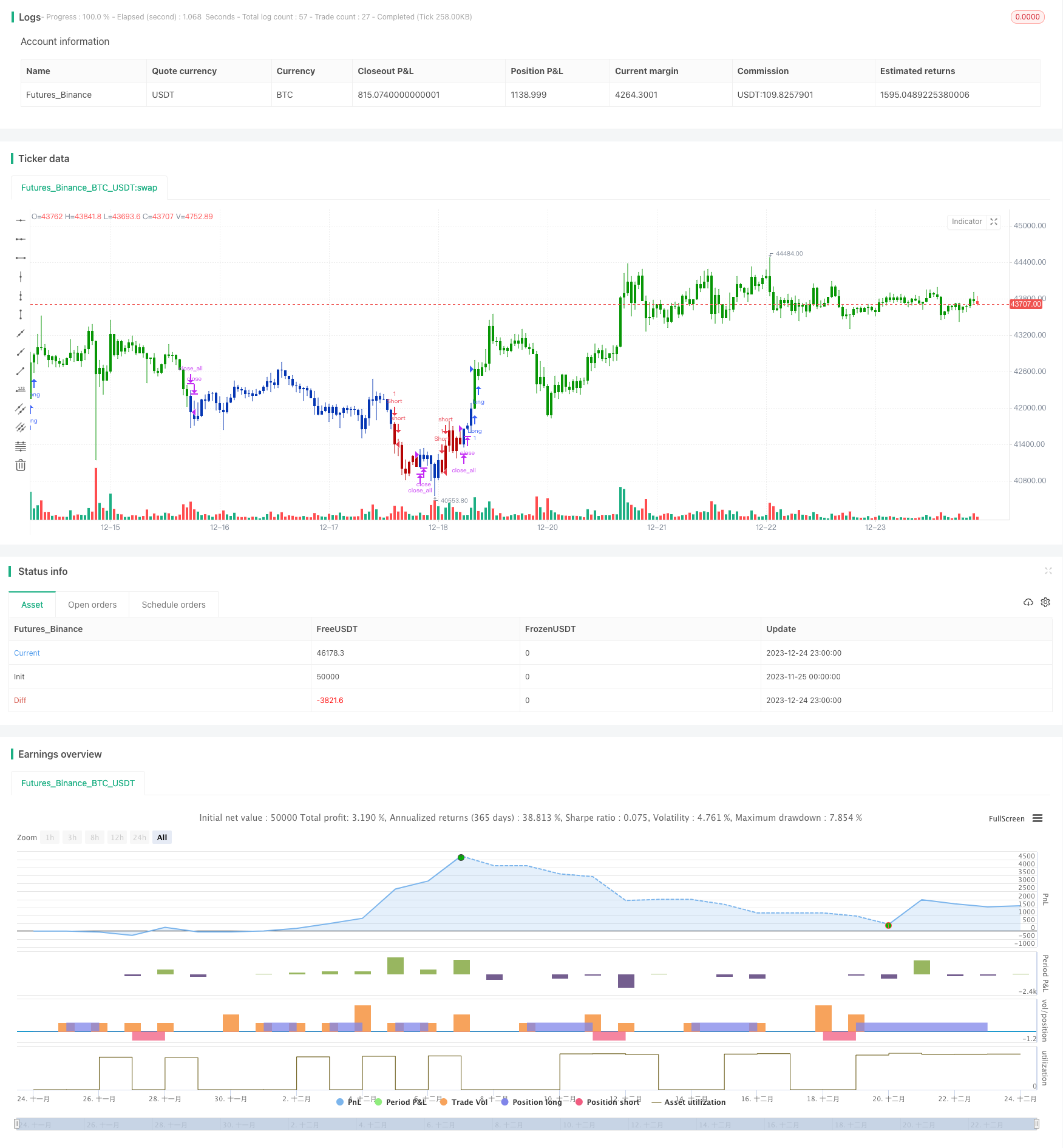
概述
该策略是基于双重因子模型的组合反转交易策略。它整合了123形态反转和增量指数两个因子,实现了策略信号的加成效应。当两个因子同时发出买入或卖出信号时,该策略才会进行相应的做多或做空操作。
策略原理
123反转因子
该因子基于价格的123形态进行操作。当前两天的收盘价关系为“低-高”并且Stoch指标低于50时,判断为底部反转信号,做多;当前两天收盘价关系为“高-低”并且Stoch指标高于50时,判断为顶部反转信号,做空。
增量指数因子
该因子基于价格波动范围的增加或减小来判断趋势反转。波动范围增大则指数上涨,范围减小则指数下降。当指数上穿某一阈值时产生做空信号,下穿时产生做多信号。
双因子同方向信号才会打开仓位,实现策略盈利,避免单一因子带来的假信号风险。
优势分析
- 双因子模型,结合价格形态和波动性指标,提高信号准确性
- 123形态判断局部 extremum,增量指数捕捉全局趋势反转点,优势互补
- 只在双因子发出同向信号时开仓,有效过滤假信号,提高策略稳定性
风险分析
- 双因子同时发出错误信号的概率存在,带来亏损风险
- 反转失败概率存在,需要设置止损以控制损失
- 参数优化不当可能导致过拟合
可以通过扩大训练集、严格止损、多因子组合过滤等手段降低风险。
优化方向
- 测试更多价格和波动性指标的组合
- 增加机器学习模型判断信号质量,动态调整仓位
- 结合交易量,布林带等因子发掘更多 Alpha
- 采用 walk forward 方法进行滚动优化,提高稳健性
总结
该策略结合价格形态和波动性指标两个因子,只在双因子发出同向信号时开仓,避免单一因子带来的假信号风险,从而提高策略整体稳定性。但也存在一定概率双因子同时发出错误信号的风险。我们可以通过扩大训练集、设置止损、因子组合优化等手段进一步提升策略表现和风险调整收益率。
策略源码
/*backtest
start: 2023-11-25 00:00:00
end: 2023-12-25 00:00:00
period: 1h
basePeriod: 15m
exchanges: [{"eid":"Futures_Binance","currency":"BTC_USDT"}]
*/
//@version=4
////////////////////////////////////////////////////////////
// Copyright by HPotter v1.0 22/02/2021
// This is combo strategies for get a cumulative signal.
//
// First strategy
// This System was created from the Book "How I Tripled My Money In The
// Futures Market" by Ulf Jensen, Page 183. This is reverse type of strategies.
// The strategy buys at market, if close price is higher than the previous close
// during 2 days and the meaning of 9-days Stochastic Slow Oscillator is lower than 50.
// The strategy sells at market, if close price is lower than the previous close price
// during 2 days and the meaning of 9-days Stochastic Fast Oscillator is higher than 50.
//
// Second strategy
// The Mass Index was designed to identify trend reversals by measuring
// the narrowing and widening of the range between the high and low prices.
// As this range widens, the Mass Index increases; as the range narrows
// the Mass Index decreases.
// The Mass Index was developed by Donald Dorsey.
//
// WARNING:
// - For purpose educate only
// - This script to change bars colors.
////////////////////////////////////////////////////////////
Reversal123(Length, KSmoothing, DLength, Level) =>
vFast = sma(stoch(close, high, low, Length), KSmoothing)
vSlow = sma(vFast, DLength)
pos = 0.0
pos := iff(close[2] < close[1] and close > close[1] and vFast < vSlow and vFast > Level, 1,
iff(close[2] > close[1] and close < close[1] and vFast > vSlow and vFast < Level, -1, nz(pos[1], 0)))
pos
MASS(Length1,Length2,Trigger) =>
pos = 0.0
xPrice = high - low
xEMA = ema(xPrice, Length1)
xSmoothXAvg = ema(xEMA, Length1)
nRes = sum(iff(xSmoothXAvg != 0, xEMA / xSmoothXAvg, 0), Length2)
pos := iff(nRes > Trigger, -1,
iff(nRes < Trigger, 1, nz(pos[1], 0)))
pos
strategy(title="Combo Backtest 123 Reversal & MASS Index", shorttitle="Combo", overlay = true)
line1 = input(true, "---- 123 Reversal ----")
Length = input(14, minval=1)
KSmoothing = input(1, minval=1)
DLength = input(3, minval=1)
Level = input(50, minval=1)
//-------------------------
line2 = input(true, "---- MASS Index ----")
Length1 = input(9, minval=1)
Length2 = input(25, minval=1)
Trigger = input(26.5, step = 0.01)
reverse = input(false, title="Trade reverse")
posReversal123 = Reversal123(Length, KSmoothing, DLength, Level)
posMASS = MASS(Length1,Length2,Trigger)
pos = iff(posReversal123 == 1 and posMASS == 1 , 1,
iff(posReversal123 == -1 and posMASS == -1, -1, 0))
possig = iff(reverse and pos == 1, -1,
iff(reverse and pos == -1 , 1, pos))
if (possig == 1 )
strategy.entry("Long", strategy.long)
if (possig == -1 )
strategy.entry("Short", strategy.short)
if (possig == 0)
strategy.close_all()
barcolor(possig == -1 ? #b50404: possig == 1 ? #079605 : #0536b3 )